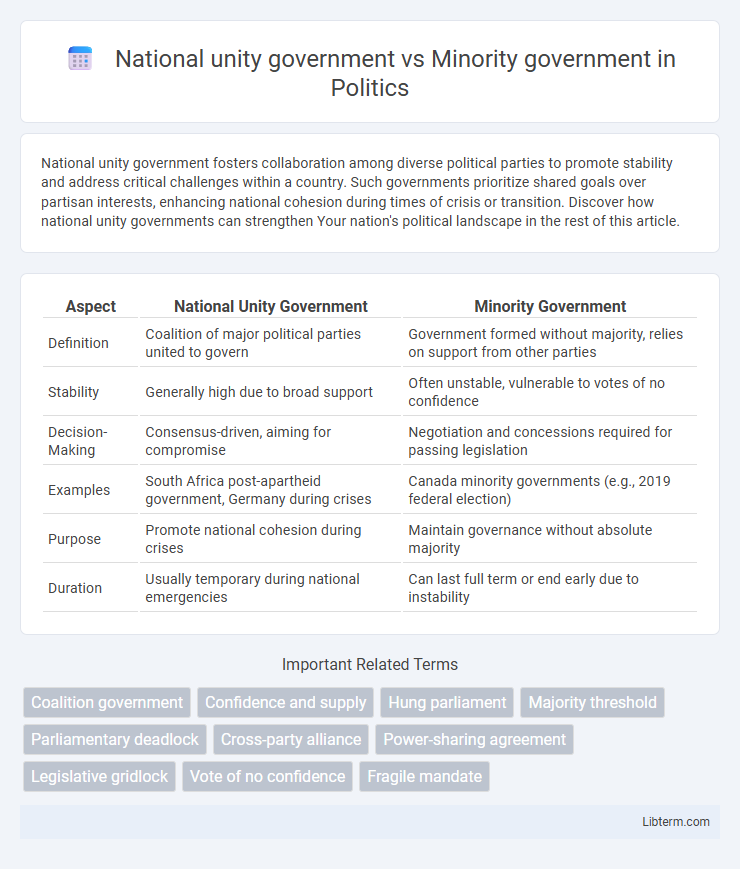National unity government fosters collaboration among diverse political parties to promote stability and address critical challenges within a country. Such governments prioritize shared goals over partisan interests, enhancing national cohesion during times of crisis or transition. Discover how national unity governments can strengthen Your nation's political landscape in the rest of this article.
Table of Comparison
| Aspect | National Unity Government | Minority Government |
|---|---|---|
| Definition | Coalition of major political parties united to govern | Government formed without majority, relies on support from other parties |
| Stability | Generally high due to broad support | Often unstable, vulnerable to votes of no confidence |
| Decision-Making | Consensus-driven, aiming for compromise | Negotiation and concessions required for passing legislation |
| Examples | South Africa post-apartheid government, Germany during crises | Canada minority governments (e.g., 2019 federal election) |
| Purpose | Promote national cohesion during crises | Maintain governance without absolute majority |
| Duration | Usually temporary during national emergencies | Can last full term or end early due to instability |
Introduction to Government Types
National unity government involves a coalition of major political parties, often spanning the entire political spectrum, formed to address extreme crises or ensure stability, resulting in broad-based executive authority. Minority government occurs when the ruling party lacks an outright majority in the legislature, relying on support from other parties to pass legislation, often leading to less stable governance. Understanding these government types reveals how power-sharing and political cooperation impact policy-making and national stability.
Defining National Unity Government
A National Unity Government is a coalition formed by major political parties across the spectrum to govern collectively during times of crisis or national importance, ensuring broad-based representation and stability. It contrasts with a Minority Government, which governs without a majority in the legislature and relies on support from other parties to pass legislation. The defining feature of a National Unity Government is its inclusive approach, uniting diverse political factions to prioritize national interests over partisan agendas.
Understanding Minority Government
A minority government occurs when the ruling party does not hold an absolute majority of seats in the legislature, relying on support from other parties to pass legislation. This government structure demands negotiation and compromise, often leading to less stable governance compared to majority or national unity governments. Understanding the dynamics of minority governments is crucial for analyzing legislative processes and policy outcomes in parliamentary systems.
Historical Contexts and Examples
National unity governments emerged during critical historical moments such as World War II in the United Kingdom, where major political parties collaborated to consolidate power against external threats, exemplified by Winston Churchill's coalition. Minority governments have frequently arisen in parliamentary systems like Canada's 2004 Liberal government led by Paul Martin, operating without a majority and relying on opposition support to pass legislation. Both forms reflect distinct responses to political instability, with national unity governments prioritizing broad consensus during crises, while minority governments navigate governance through negotiation and compromise.
Formation Processes and Requirements
National unity governments form through broad coalitions encompassing major political parties to address national crises, requiring consensus agreements and shared policy platforms. Minority governments arise when the ruling party lacks an outright majority, relying on support from smaller parties or independents without formal coalition agreements. Formation of minority governments involves negotiations for confidence and supply arrangements, while national unity governments demand extensive political compromise and collaboration.
Strengths and Weaknesses Comparison
National unity governments excel in political stability and broad consensus by including multiple parties, reducing partisan conflicts and facilitating comprehensive policy-making. Minority governments often demonstrate greater flexibility and responsiveness, relying on case-by-case support which can encourage negotiation and compromise but may lead to legislative instability and frequent voting defeats. While national unity governments can suffer from slowed decision-making due to diverse interests, minority governments face challenges in maintaining consistent support, resulting in potential government collapse and policy uncertainty.
Impact on Political Stability
National unity governments, which include broad coalitions across political parties, often enhance political stability by fostering cooperation and reducing partisan conflict during crises. Minority governments can face challenges in maintaining stability due to their reliance on support from opposition parties, leading to frequent negotiations and potential policy gridlock. The stability of minority governments heavily depends on the willingness of other parties to provide confidence and supply, whereas national unity governments typically secure a more durable consensus.
Policy Making and Legislative Effectiveness
A National unity government, composed of multiple major political parties, enhances policy-making by fostering broad consensus and reducing legislative gridlock, resulting in more comprehensive and stable legislation. Minority governments face challenges in passing policies due to reliance on opposition support, often leading to compromises and slower legislative processes. The effectiveness of legislation in national unity governments tends to be higher due to collaborative decision-making, while minority governments must strategically negotiate to secure approval and maintain governance stability.
Public Perception and Legitimacy
National unity governments often enjoy higher public legitimacy as they represent broad political consensus and aim to address national crises collaboratively. Minority governments face challenges in public perception due to their reliance on external support, which can create doubts about stability and effectiveness. Public trust in minority governments frequently hinges on their ability to maintain confidence and deliver policies without a clear majority mandate.
Future Implications and Trends
National unity governments often foster political stability and broad consensus, enabling comprehensive policy implementation during crises, yet they risk diluting opposition accountability and reducing political competition. Minority governments, reliant on support from smaller parties, tend to encourage negotiation and compromise, potentially leading to more dynamic and adaptive policymaking but also increased policy uncertainty and short-term governance. Future trends suggest a rise in minority governments due to growing political fragmentation, while national unity governments may emerge primarily in response to major national emergencies or crises.
National unity government Infographic

 libterm.com
libterm.com